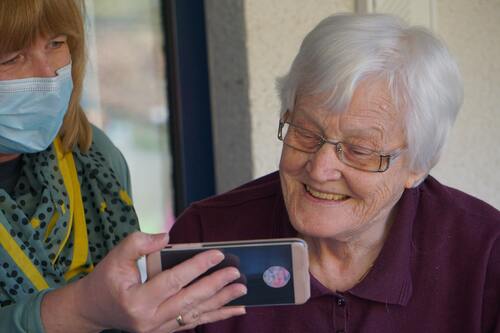UX-Design: eine klare Ansage
UX Design steht für die positive Nutzererfahrung während der Interaktion mit dem digitalen Auftritt eines Unternehmens.

Wir schaffen zufriedene Kunden
Ein durchdachtes UX-Design für Ihren digitalen Auftritt
Website
Übersichtlichkeit und einfache Bedienbarkeit - sprich: Nutzergewohnheiten müssen unbedingt berücksichtigt werden.
Online-Shop
Vom Erstkontakt bis zum Kaufabschluss alle Touchpoints der Customer Journey im Shop müssen exakt aufeinander abgestimmt sein.
Apps
Um als Anbieter erfolgreich zu sein, muss die App einen echten Mehrwert und eine sehr gute User-Experience bieten.
“Design ist nicht nur wie etwas aussieht und wie es sich anfühlt. Design ist, wie gut etwas funktioniert" Steve Jobs
Wo funktioniert UX-Design?
Ganz einfach: Im Unterschied zum User Interface Design geht es nicht um die graphische Gestaltung, sondern um die Qualität des Nutzererlebnisses.
Welche Aufgabe hat UX-Design?
Komplexe Zusammenhänge verständlich darzustellen und dem User eine klare, zielführende Benutzeroberfläche bieten.
Warum ist UX-Design so wichtig?
Der wirtschaftliche Erfolg eines digitalen Mediums hängt davon ab, welchen Mehrwert der Nutzer daraus ziehen kann. Wenn z.B. ein Online-Shop optisch attraktiv aussieht, ist das zwar positiv zu werten, sagt jedoch noch wenig aus, wie erfolgreich dieses E-Commerce sein wird
UX-Design und die Customer Journey
Im UX-Design werden Schritte perfektioniert, die der User während der Customer Journey zurücklegt: von der Informationsphase über die Auswahl des gewünschten Produktes bis zum Zahlvorgang und darüber hinaus

Analyse und Datensammlung
Sammlung und Auswertung von on- und offline Daten als Grundlage für weitere Maßnahmen
Personas und Zielgruppe
Detaillierte Kenntnisse über Personas und Zielgruppe sind elementar für ein funktionierendes UX-Design
UX-Design Konzeption
Mehrere Phasen der Entwicklung: Vom Brainstorming bis zum digitalen Prototyp
Benutzertest
Der Prototyp wird in verschiedenen Phasen getestet und geprüft.
Digitale Barrierefreiheit
Barrierefreiheit gilt auch in der digitalen Welt und ist eine echte Herausforderung für Entwickler - und ab 2025 EU-weit Standard für alle Webseiten.
Ergebnisanalyse
Die Ergebnisse aus all den voraus gehenden Etappen gesammelt, analysiert und fließen in das fertige Produkt ein. Anschließend erfolgt die Freigabe.

Erfahren Sie mehr über unsere Leistungen und vereinbaren Sie einen Termin für eine kostenfreie Beratung unter +49 (0)7575 7180 951
Analyse und Datensammlung
Im Falle einer Website, für die ein Relaunch oder Re-Design ansteht, werden Daten gesammelt und ausgewertet, welche Online- und Offline-Techniken einschließt.
Online:
- SEO-Analyse des Nutzerverhaltens bezüglich Keywords und User Intention
- Wettberber-Analyse: Navigationsverhalten der User auf einer
erfolgreichen Mitbewerber-Anwendung
- Usability-Tests auf der bisherigen Anwendung (um Fehler zu erkennen und künftig zu vermeiden)
Offline:
- Umfragen
- Case-Studies
- Berichte
- Customer Journey: Touchpoints individualisieren
Die gesammelten Daten und Erkenntnisse bilden die Grundlage für alle weiteren Maßnahmen.

Personas und Zielgruppe
Ein elementarer Teil der User Experience ist die Bestimmung der Zielgruppe anhand von Personas. Denn nur wer seine Zielgruppe und deren Bedürfnisse genau kennt, kann dem Nutzer der Anwendung ein positives Usererlebnis bieten. Die demographischen Daten, Attribute, Wünsche, Bedürfnisse und Gewohnheiten der Personas lassen Rückschlüsse darauf zu, wie das UX-Design idealerweise aussehen sollte.
Um so viele User wie möglich zu erreichen, werden Cluster generiert. Denn es kann durchaus sein, dass mehrere Personas und ergo eine breite oder mehrere Zielgruppen angesprochen werden sollen.

UX-Design Konzeption
Die Entwicklungsphase umfasst mehrere Schritte:
- Brainstorming: Hier können User mit ihren Wünschen und bisherigen Erfahrungen zu Wort kommen. Ebenso werden begangene Fehler benannt.
- Erstellung einer Sitemap: Hierarchie der Inhalte sowie die Navigationsstruktur werden definiert.
- Digitaler Prototyp in Form eines Mock-Up wird dem Kunden vorgestellt.
- Anschließend wird ein digitaler Prototyp erstellt.

Benutzertest
Der digitale Prototyp wird in verschiedenen Phasen und von verschiedenen Gruppen getestet.
Bereits während der Konzeption werden gesammelte Testerfahrungen in das Projekt mit einbezogen. Diese Erfahrungen können sich auch nur auf Teilaspekte bestimmter Anwendungen beziehen.
Eine Gruppe von Usern wird ausgewählt, die Tests an technisch präparierten Computern ausführen. Diese verfügen über Webcams zum Eyetracking und registrieren Klicks, Aufenthaltsdauer und gegebenenfalls weitere Parameter, welche für die Auswertung relevant sind.
Abschließend wird ein Usability-Report erstellt, der genau beschreibt, was in welchem Umfang und mit welcher technischen Ausstattung geprüft wurde. Auch werden die Teilnehmer benannt, Infografiken erstellt, Ergebnisse präsentiert und Empfehlungen ausgesprochen.

Digitale Barrierefreiheit
Besonderes Augenmerk verdient das Thema Barrierefreiheit. Während im realen Leben klare Normen teilweise seit Jahrzehnten vorgeschrieben und umgesetzt werden, befindet sich die digitale Barrierefreiheit noch in den Kinderschuhen. Etwa 18 Prozent der Weltbevölkerung sind, in verschiedenen Stufen, von einer Behinderung betroffen. Dazu kommt noch eine große Zahl an Senioren, die zwar nicht in den entsprechenden Statistiken auftauchen, de facto jedoch ebenfalls mit Einschränkungen zu kämpfen haben.
Was bedeutet digitale Barrierefreiheit? Alle Menschen sollen eine App oder eine Website nutzen und verstehen können. Ab 2025 gilt für alle EU-Mitgliedsstaaten der European Accessibility Act, nachdem Wahrnehmbarkeit, Verständlichkeit, Robustheit und Bedienbarkeit für behinderte Menschen gewährleistet sein soll. Praktisch umgesetzt heißt das:
- Nutzung einer einfachen Sprache
- Eindeutige Benennung von Buttons
- Alternativtexte für Grafiken und Bilder
- Musik- und Videodateien spielen sich nicht automatisch ab
- Keine ausschließliche farbliche Hervorhebung von Inhalten
Ein weiteres Argument für die Barrierefreiheit ist die Tatsache, dass jeder User, ob behindert oder nicht, von einer einfacheren Seitenstruktur und klaren Inhalten profitiert.
Wir haben uns das Thema zu eigen gemacht und setzen es konsequent um.

Ergebnisanalyse
Nachdem die Tests abgeschlossen sind, werden die Ergebnisse aus all den voraus gehenden Etappen gesammelt, analysiert und fließen in das fertige Produkt ein. Anschließend erfolgt die Freigabe durch den Kunden und die Webseite bzw. das E-Commerce oder die Applikation kann online gehen.
Natürlich sind eine weitere Kontrolle und Überwachung des UX-Designs notwendig. Insbesondere in der Anfangsphase nach der Freischaltung können noch weitere Erkenntnisse auftauchen, die kurzfristig Eingang in das UX-Design finden sollten.
Wir begleiten unsere Kunden selbstverständlich über diese Phase hinaus und bieten Updates sowie eine ständige, ganzheitliche Betreuung an.

